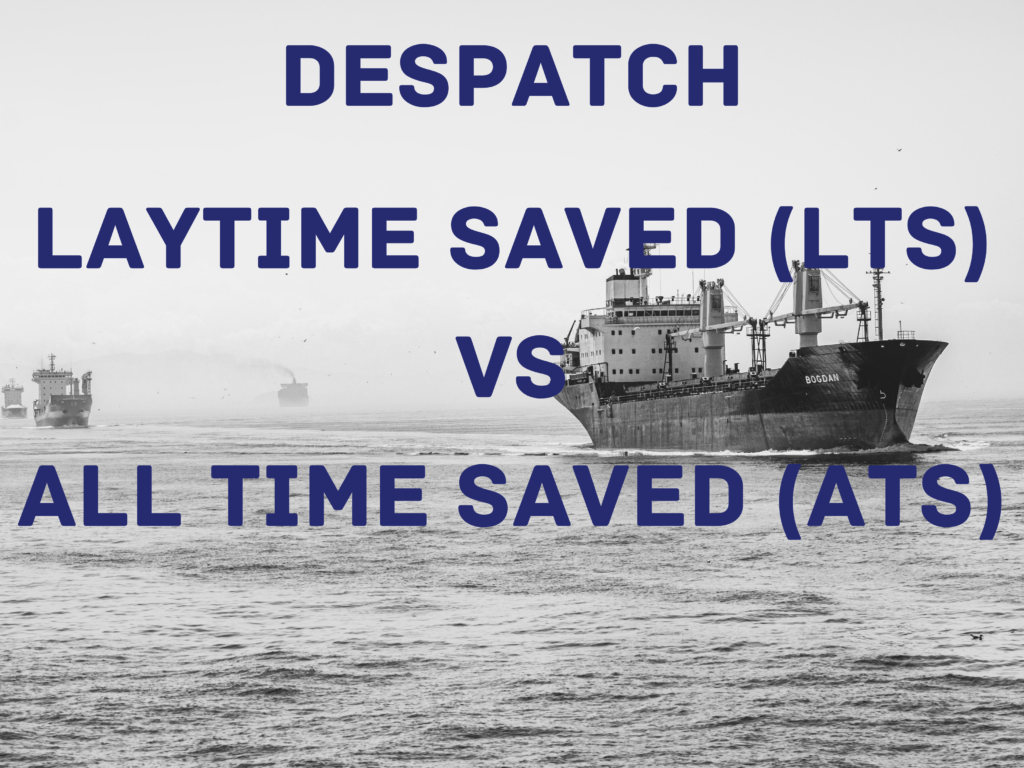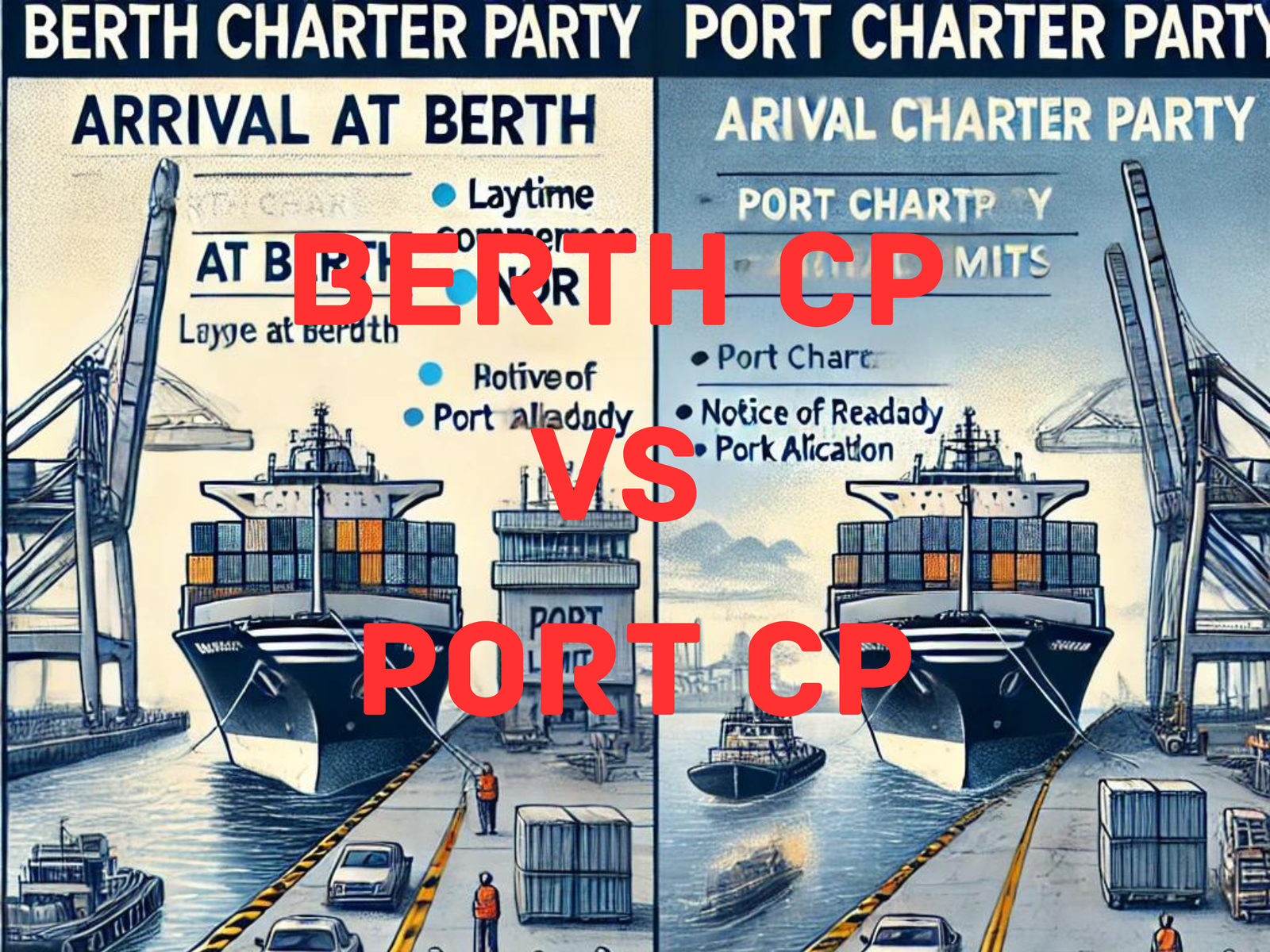In the dynamic world of maritime shipping, time management can make or break a chartering operation. Among the many concepts that play a pivotal role in this industry are Laytime Saved (LTS) and All Time Saved (ATS). While these terms may seem similar at first glance, they address different aspects of operational efficiency.
Both terms often confuse young shipping professionals who end up making mistakes in the laytime calculations and presenting an accurate claim to the counterparty. The method of calculation differs based on the time saved during the cargo operations.
This article sheds light on their unique characteristics, offering a deeper understanding of how to calculate laytime with each term.
Laytime Saved (LTS) vs. All Time Saved (ATS): The Critical Distinction

Decoding Laytime Saved (LTS) or Working Time Saved (WTS)
Firstly let us clear the confusion within similar terms. Laytime Saved or Working Time Saved or All Laytime Saved or All Working Time Saved are terms with similar meanings and if you find any one of them in the charter party terms it means that the despatch money shall be payable for the time from the completion of loading or discharging until the expiry of laytime excluding any periods excepted from the Laytime as per the charter party terms.
Working time may be taken to mean the periods, which include the customary working hours of the port.
If the despatch is payable on the working time saved and the number of hours saved is 48 hours, the owners will divide this by 24 (hours per calendar day) to obtain a figure of 2 days despatch. Sundays and Holidays would not usually be normal “working” time and would be excluded from time saved.
This expression generally means the same as “all laytime saved”. The only thing that differentiates them is that, in this situation, if there are exceptions to laytime, these will also apply to periods for which no despatch is payable.
Example:
A ship owner and a charterer in a charter party contract agreed on a laytime of 7 days for the loading port and 7 days for the discharging port, a total of 14 days. The charter party states that the charterer will be paid despatch at a rate of 10,000 USD per day on Working Time Saved (WTS).
At the Loading port, the charterer managed to load in 5 days, saving 2 days from the allowed time. However 1 day falls on a weekend when cargo operations would not be carried out, Therefore only 1 day of working time is saved at the loading port.
The vessel then arrives at the discharge port, where the charterer efficiently discharged the vessel in 6 days, saving 1 day of laytime. In this case, the saved day is a working day.
The charterer in total saved 2 days, therefore they will receive despatch money for 2 days which is 2 x 10,000 USD = 20,000 USD
Key Features of Laytime Saved (LTS)
- Despatch on Working Time Saved calculates the financial reward on the actual working time saved during cargo operations.
- It considers only the time saved when cargo operations are actively carried out, excluding non-working periods such as weekends, holidays, or unforeseen stoppages.
- This method focuses on rewarding the character for their efficiency during actual working hours, as it takes into account only the time saved during those periods.
- If despatch is payable at all working time saved, this is more advantageous to the shipowner.
Unpacking All Time Saved (ATS)
All Time Saved means that the despatch money shall be payable for the time from the completion of loading or discharging to the expiry of laytime including the periods excepted from the laytime.
Example:
In the same situation as the examples above, Despatch All Time Saved (ATS) means that the calculations include any period excepted from the laytime.
Laytime allowed – 5 days SHEX (Sunday and Holiday Excluded)
The ship completed loading on Friday and used only 3 days
In All Time Saved (ATS), no exclusions are applicable and time saved will be 2 days at the load port and 1 day at the discharge port, resulting in a despatch of 3 days.
The charterer in total saved 3 days, therefore they will receive despatch money for 3 days which is 3 x 10,000 USD = 30,000 USD
Despatch All Time Saved (ATS) requires the port agent to prepare the Statement of Facts (SOF) even after the ship has sailed from the port so that calculations can be prepared to take into account the periods excepted from the laytime as per terms agreed in the charter party.
Key Features of All Time Saved (ATS)
- Despatch on All Time Saved calculates the financial reward based on the total time saved during cargo operations, irrespective of whether it is working or non-working time.
- It considers all the saved time, including weekends, holidays, and other non-working periods.
- This method rewards the charterer for overall efficiency in cargo operations, without differentiating between working and non-working hours.
- Chartering a ship on a Despatch All Time Saved (ATS) basis would be more advantageous to the charterer.
Contrasting Laytime Saved and All Time Saved
Let’s once again differentiate both the despatch terms with the help of a practical situation.
Vessel Name: MV AMIT YADAV
Terms: PWWD of 24 Consecutive Hours, SSHEX EIU (In normal conditions time from Sat 0001 to Sun 2400 will not be counted)
Laytime allowed at load port: 5 days
Commenced Loading: 6th Jan 2025 at 1200 hours LT (Monday)
Completed Loading: 10th Jan 2025 at 1200 hours LT (Friday)
Laytime Ends on: 13th Jan 2025 at 1200 hours LT (Monday) (Assuming if vessel would have continued operations and used the full time allowed when would the laytime end, Sat and Sun are excluded
6th Jan 1200 – 7th Jan 0000 = 0.5 day (Monday)
7th Jan 0000 – 7th Jan 2400 = 1 day (Tuesday)
8th Jan 0000 – 8th Jan 2400 = 1 day (Wednesday)
9th Jan 0000 – 9th Jan 2400 = 1 day (Thursday)
10th Jan 0000 – 10th Jan 2400 = 1 day (Friday)
11th Jan 0000 – 11th Jan 2400 = 0 day (Saturday)
12th Jan 0000 – 12th Jan 2400 = 0 day (Sunday)
13th Jan 0000 – 13th Jan 1200 = 0.5 day(Monday) )
Despatch calculations for Laytime Saved and All Time Saved are calculated from Completion of Loading until the expiry of Laytime Allowed.
| DAY | Laytime Saved (LTS) / Working Time Saved (WTS) | All Time Saved (ATS) |
|---|---|---|
| 10th Jan 1200 – 10th Jan 2400 (Friday) | 12 hours (0.5 day) | 12 hours (0.5 day) |
| 11th Jan 0000 – 11th Jan 2400 (Saturday) | 0 hours | 24 hours (1 day) |
| 12th Jan 0000 – 12th Jan 2400 (Sunday) | 0 hours | 24 hours (1 day) |
| 13th Jan 0000 – 13th Jan 1200 (Monday) | 12 hours (0.5 day) | 12 hours (0.5 day) |
| Time Saved | 1 Day | 3 Day |
| Despatch per Day = 10,000 USD | 1 x 10,000 = 10,000 USD | 3 x 10,000 = 30,000 USD |
| Beneficial for Owners | Beneficial for Charterers |
| Attribute | Laytime Saved (LTS) | All Time Saved (ATS) |
|---|---|---|
| Scope | Limited to the unused portion of laytime | Includes all saved time, even beyond laytime |
| Primary Use | Integral to charter agreements and dispatch | Reflects overall operational efficiency |
| Financial Impact | Often rewarded with dispatch payments | May not yield direct financial benefits |
| Operational Focus | Measures adherence to laytime limits | Evaluates holistic time-saving efforts |
Why Understanding These Differences Matters
Distinguishing between Laytime Saved (LTS) and All Time Saved (ATS) is not just a matter of semantics—it’s a critical aspect of managing time and costs in maritime shipping. Laytime Saved focuses on adherence to contractual obligations and is often tied to financial incentives, while ATS serves as a broader indicator of operational efficiency. Together, these concepts offer a comprehensive framework for analyzing and improving shipping operations.
Final Thoughts
For shipowners, charterers, and cargo handlers, mastering the nuances of Laytime Saved and All Time Saved can lead to smarter decision-making and more efficient operations. Whether negotiating dispatch terms or assessing overall performance, these metrics provide the tools needed to thrive in the fast-paced maritime industry. By leveraging both LTS and ATS strategically, stakeholders can enhance productivity, reduce costs, and maintain a competitive edge in global shipping.
Are you already familiar with Notice of Readiness (NOR)? If not please refer to our blog “Essential Guide to Notice of Readiness (NOR) in Shipping“
For more information contact us.















